-
current
recommendations- Liefdefjord
New page dedicated to one of Spitsbergen's most beautiful fjords. Background information and many photos.
- New Spitsbergen guidebook
The new edition of my Spitsbergen guidebook is out and available now!
- Liefdefjord
New page dedicated to one of Spitsbergen's most beautiful fjords. Background information and many photos.
Page Structure
-
Spitsbergen-News
- Select Month
- April 2025
- March 2025
- February 2025
- January 2025
- December 2024
- November 2024
- October 2024
- September 2024
- August 2024
- July 2024
- June 2024
- May 2024
- April 2024
- March 2024
- February 2024
- January 2024
- December 2023
- November 2023
- October 2023
- September 2023
- August 2023
- July 2023
- June 2023
- May 2023
- April 2023
- March 2023
- February 2023
- January 2023
- December 2022
- November 2022
- October 2022
- September 2022
- August 2022
- July 2022
- June 2022
- May 2022
- April 2022
- March 2022
- February 2022
- January 2022
- December 2021
- November 2021
- October 2021
- September 2021
- August 2021
- July 2021
- June 2021
- May 2021
- April 2021
- March 2021
- February 2021
- January 2021
- December 2020
- November 2020
- October 2020
- September 2020
- August 2020
- July 2020
- June 2020
- May 2020
- April 2020
- March 2020
- February 2020
- January 2020
- December 2019
- November 2019
- October 2019
- September 2019
- August 2019
- July 2019
- June 2019
- May 2019
- April 2019
- March 2019
- February 2019
- January 2019
- December 2018
- November 2018
- October 2018
- September 2018
- August 2018
- July 2018
- June 2018
- May 2018
- April 2018
- March 2018
- February 2018
- January 2018
- December 2017
- November 2017
- October 2017
- September 2017
- August 2017
- July 2017
- June 2017
- May 2017
- April 2017
- March 2017
- February 2017
- January 2017
- December 2016
- November 2016
- October 2016
- September 2016
- August 2016
- July 2016
- June 2016
- May 2016
- April 2016
- March 2016
- February 2016
- January 2016
- December 2015
- November 2015
- October 2015
- September 2015
- August 2015
- July 2015
- June 2015
- May 2015
- April 2015
- March 2015
- February 2015
- January 2015
- December 2014
- November 2014
- October 2014
- September 2014
- August 2014
- July 2014
- June 2014
- May 2014
- April 2014
- March 2014
- February 2014
- January 2014
- December 2013
- November 2013
- October 2013
- September 2013
- August 2013
- July 2013
- June 2013
- May 2013
- April 2013
- March 2013
- February 2013
- January 2013
- December 2012
- November 2012
- October 2012
- September 2012
- August 2012
- July 2012
- June 2012
- May 2012
- April 2012
- March 2012
- February 2012
- January 2012
- December 2011
- November 2011
- October 2011
- September 2011
- August 2011
- May 2011
- April 2011
- March 2011
- February 2011
- January 2011
- December 2010
- November 2010
- September 2010
- August 2010
- July 2010
- June 2010
- May 2010
- April 2010
- March 2010
- February 2010
- November 2009
- October 2009
- August 2009
- July 2009
- June 2009
- May 2009
- April 2009
- March 2009
- February 2009
- January 2009
- December 2008
- November 2008
- October 2008
- August 2008
- July 2008
- June 2008
- May 2008
- April 2008
- March 2008
- February 2008
- April 2000
- Select Month
-
weather information
-
Newsletter

| Guidebook: Spitsbergen-Svalbard |
Home → April, 2021
Monthly Archives: April 2021 − News & Stories
Spitsbergen with SV Antigua (23.6.-11.7.): cancelled due to Corona
This latest cancellation due to the corona crisis is definitely a hard blow: the long Spitsbergen trip with SV Antigua from June 23 to July 11, 2021, is now cancelled. The participants will now be contacted by the Geographischen Reisegesellschaft.
We had to make a decision together with the owner of the Antigua, the Tallship Company. The current corona development and related travel restrictions did not leave us with any other choice. We would have loved to see a more efficient start of the European vaccination programme, this might have made a difference but it was too slow to enable this kind of travelling in June/July.
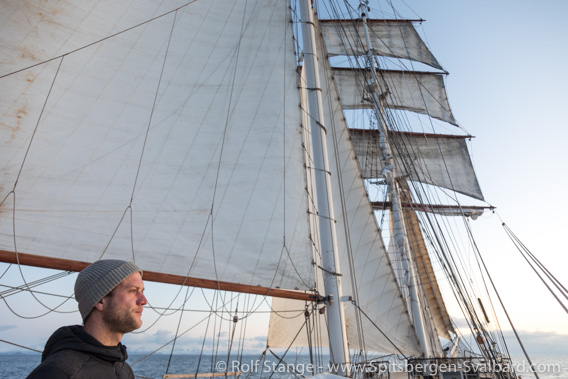
Spitsbergen with Antigua (June 23 – July 11): cancelled because of corona.
Finger crossed that we can carry out the remaining trips later in the season, with SY Arctica II in August/September and SV Antigua in September.
It probably goes without saying: anyone who wants to travel this summer, will be well advised to make use of the first opportunity to get a corona vaccination. Nothing is official as of now, but it appears to be a realistic scenario that Norway may lift travel restrictions and possibly enable participation in ship-based tourism initially for those who are fully vaccinated.
Trappers Trail: local dog sledge race took place
These days, it is news in itself if something actually happens! This was the case last weekend, when the local dog sledge race “Trappers Trail” took place. You can’t possibly imagine a public event with better distance and ventilation than a dog sledge race!
“Trappers Trail” is an annual event organised by the Longyearbyen dog club (hundeklubben) – they are the ones with the kennel near the polar bear warning sign next to the lake in Adventdalen. It is an event for local members of the club, more a social event than a competition. Well, it is also a competition, but it is more than just that.
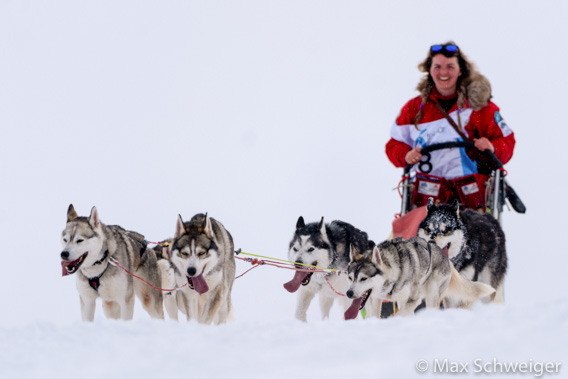
Start of this year’s Trappers Trail: the traditional dog sledge race
for the members of the Longyearbyen dog club.
The Trappers Trail race takes two days. The route does require a good level of training from all participants, both on four and on two legs. It takes them from Longyearbyen via Adventdalen, Todalen, Bødalen and Colesdalen to Colesbukta – about 40 km in total – where the dog club has a club house. The participants spend a night in tents and then return via Fardalen and the glacier Longyearbreen. This second leg is about 30 km long – a bit shorter, but Fardalsbakken, the ascent from Fardalen up to the pass over to Longyearbreen, will push most teams into their reserves, before the long descent down Longyearbreen usually provides a relaxed final run back to Longyearbyen.
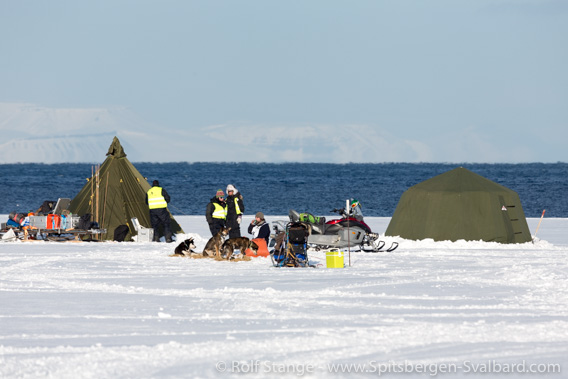
Colesbukta is the destination of the first day. Here, Longyearbyen dog club owns a hut and the participants of the Trappers Trail race spend a night in tents before they return on Sunday
(archive image).
The race is an annual highlight for the club members and local onlookers. The complete event happens outside and was thus possible to happen also under corona conditions.
Trappers Trail: Photo gallery
Max Schweiger was on location and provided photos – tusen takk, Max!
- gallery anchor link: #gallery_1968
Click on thumbnail to open an enlarged version of the specific photo.
Arctic online presentations “Arctic Wednesday”: final night with Thomas Ulrich
It started with a couple of presentations in November and December, and in January, Birgit Lutz and I joined forces and created the online presentation series “The Arctic Wednesday”. Next Wednesday, 28 April, the current series will come to an end, when the Swiss polar adventurer Thomas Ulrich takes up to the highest latitudes. “Arctic Solo” is the dramatic story of a North Pole Expedition that brought Thomas into dangerous and desperate situations – ant it is the story of Thomas finding a way out and to continue stronger than ever.
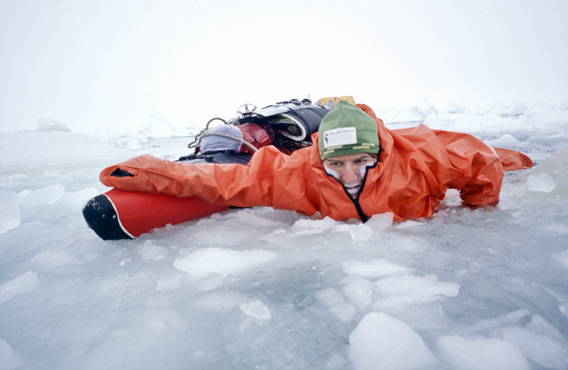
Thomas Ulrich: “Arctic Solo”. A dramatic adventure as the final highlight of the arctic online presentation series “The Arctic Wednesday”.
Where Birgit and I, with contributions by Udo Zoephel (the MOSAiC-expedition), Sandra Walser (Hans Beat Wieland/Wilhelm Bade) and Henry Páll Wulff (Iceland), focussed on knowledge of different arctic areas and various chapters of the regional history, Thomas will take us out into the wild! A final highlight that were a really excited about, and we hope that many of you will join us!
The presentation will be in German. Click here for tickets.
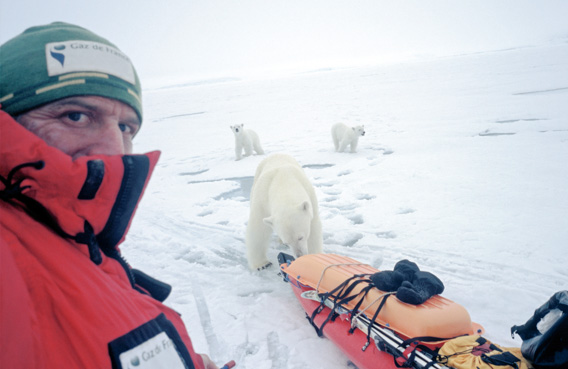
In the presentation “Arctic Solo”, we will encounter a lot of ice, icy temperatures and definitely a polar bear every now and then.
The project “The Arctic Wednesday” has developed with amazing force and it has kept us busy for several months. It has carried us through a period that is not the easiest of all times for the travel industry, especially for self-employed/freelance guides/expedition leaders/authors/photographers who often can not count on public support during the corona crisis. So the “Arctic Wednesday” has been a project of vital importance for us – a big, warm, heart-felt “thank you” to everybody who has joined us on Wednesday evenings since early January! We will continue, that’s pretty sure. But after next Wednesday’s presentation, it is time for a break. Both Birgit and I have got other projects that do require our attention, and let’s hop that the arctic summer will give us the chance to travel again. Fingers crossed!
Thomas Ulrich: Arctic Solo (presentation)
Some impression of Thomas Ulrich’s arctic adventures. Join us on Wednesday for more!
- gallery anchor link: #gallery_1920
Click on thumbnail to open an enlarged version of the specific photo.
Cod war between Norway and EU about to escalate
A new “cod war”, a conflict about fishing rights, has been lurking in the Barents Sea already for some time. The problem is a disagreement about cod quotas for European fishing ships in the 200 mile zone around Svalbard. The matter is complex.
The problem: EU fishing quotas after the Brexit
On the surface, the problem appears to be new quotas for European fishing vessels that Norway has set after the Brexit by deducting the British quota from the European allowance. The new European quota amounts to 17,885 tons, according to NRK, while British fishing vessels are afforded a quota of 5,000 tons. The EU, however, is not happy about this new quota and reacted by allocating themselves a quota of 28,431 tons, something that is not accepted by Norway. The EU accused the current Norwegian fishery policy of being arbitrary and discriminatory.
Both sides have now verbally rigged up, both saying they are prepared to take steps as necessary to take care of their rights. Norway has made clear that coastguard and police are ready to take the usual steps in case they find fishing vessels with illegal catch in their waters, including confiscation of ships and catches and arrestation of crews. It was Lars Fause, chief prosecutor in north Norway, who said this. Later this year, Fause will follow Sysselmann Kjerstin Askholt in Longyearbyen as the first one to bear the gender-neutral title Sysselmester.
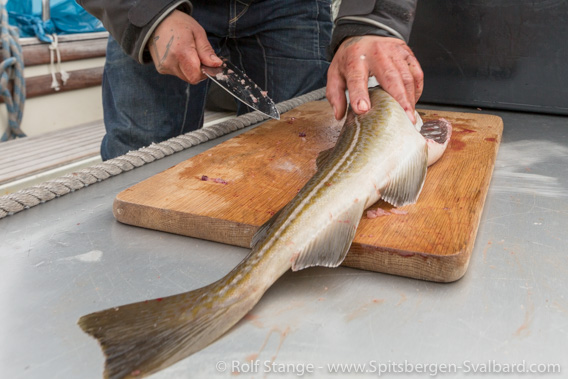
Yummy cod taken in Isfjord.
The conflict between the EU and Norway is, however, about other volumes.
Key problem: the Spitsbergen Treaty
But the essential problem is hidden in the paragraphs of the Spitsbergen Treaty. The second article of the treaty guarantees that “Ships and nationals of all the High Contracting Parties shall enjoy equally the rights of fishing and hunting in the territories specified in Article 1 and in their territorial waters.” The problem is the definition of “territorial waters”. The Spitsbergen Treaty was signed in 1920. Until then, most countries looked upon coastal waters within 3 miles (a gun shot) as their territorial waters. It was not before 1921 that governments began to include the waters as far out as 12 miles into their own territory. Until today, this is not everywhere as clearly defined as one might think or wish, but as far as this, there is consensus in the area in question: everybody agrees that the Spitsbergen Treaty is valid within the 12 mile zone (territorial waters) around Svalbard, meaning that fishing ships of all treaty parties enjoy equal rights there.
The problem starts when it comes to the exclusive economic zone (EEZ), which stretches as far as 200 miles from the coast. Hence, the EEZ is much larger and includes large and valuable biological resources. The EEZ was, however, not defined in internatinal law before 1982, when the United Nations Convention on the Law of the Sea was concluded.
Based on article 1 of the Spitsbergen Treaty, Norway claims “full and absolute sovereignty” also of the large exclusive economic zone (200 mile zone), but insists at the same time that article 2 ot the same treaty, which gives all treaty parties equal rights, is not valid there. In contrast, Norway claims exclusive rights in the EEZ. It does not really surprise that there are those treaty parties who do not agree with this position.
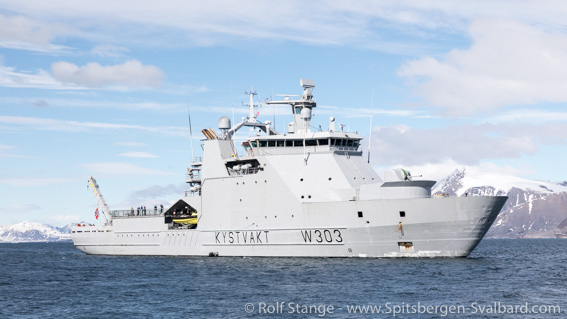
The coastguard guarantees Norwegian sovereignty in the waters around Spitsbergen. Unfriendly encounters of coastguard vessels and EU fishing vessels may be coming up.
The Spitsbergen Treaty and the “exclusive economic zone (EEZ)”
Whatever one’s position is on the question wether or not the Spitsbergen Treaty and its fundamental principle of equal rights and access (non-discrimination) is to be applied in the EEZ, there can hardly be any doubts that fishing vessels from the EU or third countries need to respect Norwegian economical rights in these waters. The question is, however, how Norway may balance the quotas that are allocated to foreign fishing vessels relative to their national quotas: according to the principle of non-discrimination (if article 2 of the Spitsbergen Treaty is to be applied) or exclusively.
A complex matter. What is clearly missing is an authority accapted by all sides that could decide on such matters of interpretation regarding the Spitsbergen Treaty. Norway insists to possess the exclusive authority to such questions, but that is not accepted by Brussels.
While there is political and juridical need for clarification, both the Norwegian coastguard and European fishing vessels are getting prepared and conflicts are to be feared. The staggered observer keeps watching and wondering.
Victims of domestic violence in Svalbard potentially in defenceless position
Krisesenteret Tromsø, an institution to help victims of domestic violence, has raised an alarming debate. According to an article published in NRK, victims of domestic violence may be in a far more helpless situation in Longyearbyen than in mainland Norway.
Background: the Spitsbergen Treaty
The background is related to the Spitsbergen Treaty, according to which citizens of all signatory countries have free access to Svalbard. As a result, everybody can live and work there without visa and work permit restrictions (a Schengen visa can be necessary to get to Spitsbergen because access is only available through the Schengen treaty area).
Hence, the Norwegian “utlendingsloven” (foreigner law) is not valid in Svalbard, which regulates access and residents of foreigners in Norway. But this law also provides support to non-Norwegian victims of domestic violence in Norway, for example access to dedicated institutions such as Krisesenteret Tromsø (or elsewhere) and to lawyers, to name some examples. This is not available in Longyearbyen, because the law is not valid in Svalbard. This can put foreign women, who are financially dependent on their partner, in a very difficult position: if they are not able to support themselves financially, then returning to their country of origin is likely to be the only solution available. But these countries do often not provide much of a perspective, especially for people who have left years ago and who may now have children who may not have much of a relationship their mother’s country of origin. As a result, such women may stay in a violent relationship longer than they might have done with more support.
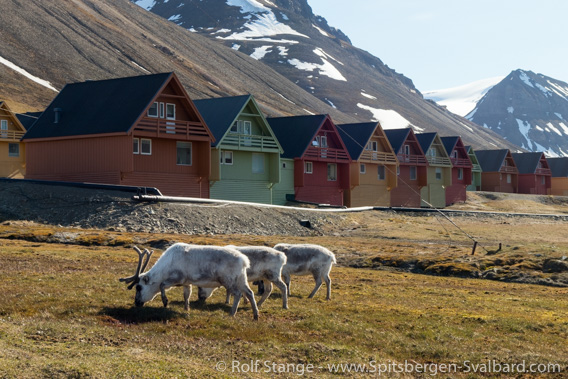
For most people, Longyearbyen is a good place where you can have a good and safe life.
But there are exceptions, and for them, life can be even more difficult than it would be in mainland Norway.
A lawyer who works with victims of domestic violence comments this as follows: “It appears as if Svalbard is Norwegian when it suits us and suddenly it is not Norwegian when it does not fit us.”
Two police cases of domestic violence since 2020
Two cases of domestic violence have been investigated by the police since early 2020. Sysselmann Kjerstin Askholt points out that the police follows these cases up just in the same way as on the mainland. She sees Norwegians who live without residence permit in a foreign country in a relationship with a local in a similar situation and explains that, for the victim, these cases may always have other consequences than for a citizen of the respective country.
Mayor Arild Olsen recognises the problem and sees the need to investigate the matter on a political level.
Hanne Stenvaag, leader of the krisesenteret (crisis centre) in Tromsø, is afraid that there may be a high number of unreported cases.
Parts of Nybyen closed because of avalanche risk
The weather in Spitsbergen has largely been rather unfriendly for a while with a lot of wind, snow and comparatively mild temperatures. The Easter weekend was not as ideal for long trips into the outdoors as many would have wanted. A group of ski expeditioners who wanted to go “Spitsbergen på langs”, a demanding tour from the south cape to the north point of the main island, had to be picked up by helicopter just days after the start.

Gruvefjellet above Nybyen (the buildings are part of Nybyen).
Currently, the weather forecast again includes a lot of wind and snow for Longyearbyen and large parts of Svalbard, and this involves a high avalanche risk. The official warning system
wieder Wind und Schnee bereit. Daher gilt in Longyearbyen und großen Teilen Svalbards wieder varsom.no is now on “red” (stage 4 out of 5).
Large cornices have built up at Gruvefellet next to Nybyen, the upper part of Longyearbyen. These cornices may break off at any time and put buildings at risk. The Sysselmannen has concluded that the only way to keep everybody safe is to evacuate parts of Nybyen until further notice. This includes the buildings on the east side of the road and the adjacing slope of Gruvefjellet. Everybody has to leave from this area until 1800 today (Friday). The evacuation can only be lifted by the Sysselmannen, and it is not known when this will happen.
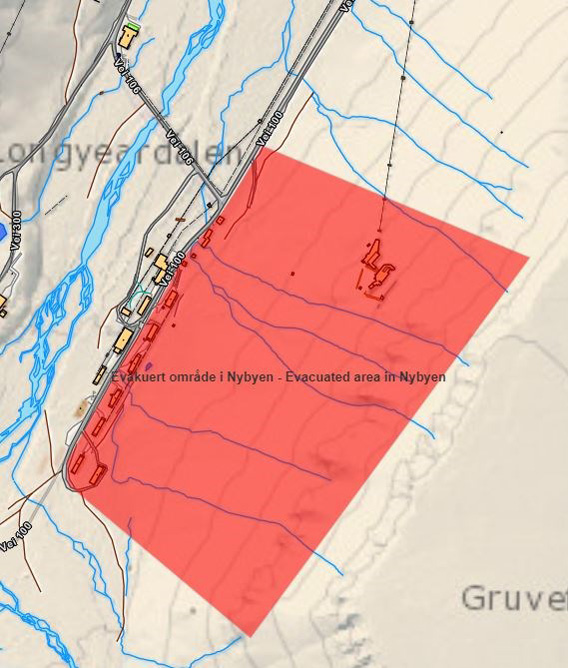
The closed area in and near Nybyen.
Map © Norsk Polarinstitutt / Sysselmannen på Svalbard.
News-Listing live generated at 2025/April/30 at 19:39:36 Uhr (GMT+1)














































